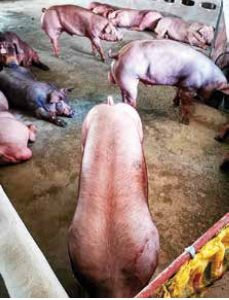Thailand’s PKP6 Farm’s investments in a mid-sized slaughter house in Prachin Buri and expanded feed mill capacity are aimed at boosting cost-competitiveness and quality ahead of a long-term plan to enter the retail meat business.

Pawapat Pathompothiwat, production director of PKP6, said the decision to get involved in processing was driven by customer demand. Over the past two years, brokers and regular customers who trade in live hogs were increasingly asking the company to invest in a hygienic slaughterhouse.
The hog business in Thailand has shifted towards integration, with producers expanding their scale and going direct to end customers. The changes accelerated in 2017 when prices for live animals plunged, prompting farm owners to integrate their operations to capture more value. More and more pork stores are appearing.
The middlemen are under pressure and fear the end is nigh due to soaring busi- ness costs and a serious worker shortage.
A farm with its own slaughtering operation can eliminate the middlemen in the pork supply chain, he said. But doing that means meat packing will have to become more localized.
Even at fire sale prices, meat from far away will find it difficult to enter local markets because any local butcher shop selling their own pork would be reluctant to risk their reputation by selling meat of unknown quality.
Size doesn’t matter much anymore. Nowadays, supply chain management is more important. A well-run, integrated, 4,000-sow capacity, mid-sized farm supplying its own well-established retail channels would stand to make more profit than competitors who are operating larger operations but still dependent on middlemen, said Mr Pawapat.
The pork business faces a much tougher regulatory environment. The Ministry of Agriculture’s new regulation BE 2555 on slaughterhouse establishments requires all such operations to have effluent treatment systems. Thus, the operating licenses of those who have no or substandard water treatment systems will not be renewed. Also, operators mixing feed for internal use, mostly mid-size growers, will be required to be GMP certified.
Mr Pawapat said that PKP6’s new 100-million-baht hog processing plant will open in March 2019 with an initial capacity of 400 head/day. The processing unit has a cut up section and chillers.
The project will break even within seven years, provided that it operates at a minimum of 300 head/day. PKP6 will open five shops on the outskirts of Prachinburi in 2020. It has already begun selling split carcasses to customers and cut up parts via its existing outlet.
The processing operation will entrench the company’s market position and pave the way for future branding. This will be based on supplying the market with premium quality pork from a standardized, hygienic processing plant, said Mr Pawapat.
No antibiotic growth promoters
PKP6 is preparing to build a new feed mill to produce 6,000 tonnes/month of mash feed in a new location which complies with the DLD’s new regulations. The plant is also designed to accommodate business growth and handle new kinds of feed ingredients.

Feed ingredients are primarily broken-rice, rice bran, solvent-extracted rice bran and corn. Herd performance is relatively stable and pig flow is steady, but there is a lot of room for slashing feed costs.
PKP6 recently tried adding cassava pulp to the ration. The result was satisfactory with big savings in feed costs. Pro- and pre-biotic additives are used in the feed, and a proper vaccination program together with stringent biosecurity keeps the herd healthy.
Medication costs are low because PKP6’s farm is located in a secluded area, which helps to keep the animals healthy. Breeders and finishers are reared in evaporative-cooled housing.
The farm uses high quality sh meal in creep feed and pre-starter feed. The rest are fed a vegetarian diet to reduce the risks borne by animal protein, especially African swine fever.
No live animals have been brought into the farm in the last three years. GGP semen is imported and breeding stock is selected from within the operation with the help of genetics consultants.
Its goal is to produce a steady flow of pigs with the least possible mortality. Mortality from birth to 10 weeks of age is around 1% and from birth to finish is below 5%. The lower the mortality, the better the bottom line, he said.
Feed cost/kg of gain in finishing hogs is around 36 baht.
The farm has refrained from using antibiotic growth promoters in sows. Medicated premixes have been replaced with probiotics for gestation and lactating sows since 2016.
Antibiotics are reserved for use only in treating specific cases. Prophylactic doses of haloquinol in pre-starter feed were totally withdrawn in 2018. Growth performance and mortality is unchanged, even after removing antibiotics. Furthermore, the cost of production has declined and growth performance is more stable.
“Viral load in the farm has declined during the last three years after using probiotics. Feed intake and average daily gain has improved. FCG is intact while mortality and sows with lameness issues have declined,” said Mr Pawapat.
PKP6’s sow replacement rate is kept at 35% to keep genetic improvements in line with growing demand for high yielding carcasses that are long and contain a high proportion of lean meat. Also, gestation crates have been modified to support longer sows. At present, the gilt crate is 0.65m x 2.2m, and sow crates 0.80m x 2.2m.
Business transformation
With the upcoming investments, PKP6’s business model will shift from selling live animals to meat. It will increase sales of split carcasses and add more pork retail shops in Prachinburi.
Currently, its breeding herd includes GGP, GP and PS. It runs around 2,000 sows and operates finishing units internally. Half of the piglets are sold to pig integrators and the rest go to its own finishing farms.
Prachin Buri and eight other provinces, including Chachoengsao, Chon Buri, Chanthaburi, Trat, Nakhon Nayok, Srakeaw and Samut Prakan, are part of a 37,759 km2 national FMD-free zone. Importation of offal, bone-in pork and more from other areas to these provinces is restricted. D
Beside the obvious biosecurity advantages, the zoning means Prachin Buri is naturally protected against imports of pork from other areas, which helps minimize supply volatility.
Production

Its finishers are a three-way cross: duroc x landrace x large white. Piglets are weaned at 21-28 days and reared in the nursery for 35 days to reach a bodyweight of 25 kg before being sent to growing and finishing units. Finishers reach market weight of 100-110 kg within 112-119 days.
A single-age, all-in-all out production system is used. Nursery houses are to be refurbished based on a piglet-centric concept with upgraded slat flooring and improved ventilation.
The piglet unit improvements won’t be cheap, but are being considered an investment that will be recouped by performance gains and improved herd health, he concluded.
